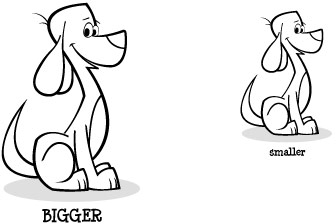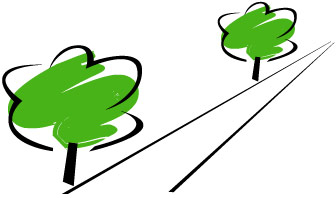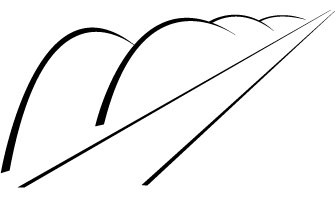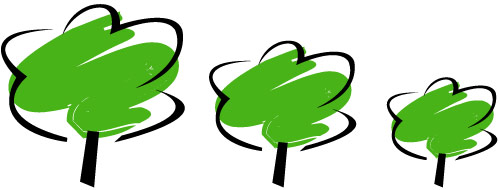Perspective Drawing for Beginners | Bigger and Smaller
from the Learn to Draw Index
Now that you have developed a few basic drawing skills, let's try perspective drawing.
To make things look a little less "flat", and more like they are in the "real" world, you need to add perspective. This is a subject that you could spend oodles of time on, and still not know everything. However, the basic idea is this:
If it's close, it's bigger. If it's far away, it's smaller.
You probably already knew that, though you may not have thought to apply it to your drawing.
In the following picture the first puppy is bigger and the second puppy is smaller. They aren't really. They just seem that way. The second puppy is just disappearing in the distance.

Here's another example. In the following picture you see a road with two trees on the far side. Which tree is bigger?

In real life, both trees would be the same size. In this drawing, however, the tree on the right is smaller to make it look like it's further away.
Let's try a project. Draw a scene on a blank piece of white paper that looks something like the scene below. It doesn't have to be perfect.

Next, cut out three trees that are exactly the same size, and three trees that are different sizes. You can cut them out of construction paper, or copy and paste these trees into a word processing document and print them.

Place three same size trees on your scene. Next, place three different sized trees on your scene.
Which seems right?
The correct answer is three trees of different sizes. These trees will give perspective to your art, and make things seem a bit more like they are in the real world.
If you didn't guess correctly, you still get full points for trying.
Let's try another lesson: Lesson 2: One-Point Perspective
For Teachers
This lesson is one of three lessons designed to introduce perspective drawing to elementary art students. The first lesson begins with bigger/smaller aspect of objects when we consider them in perspective. The next two lessons will introduce one-point and two-point perspective.

|